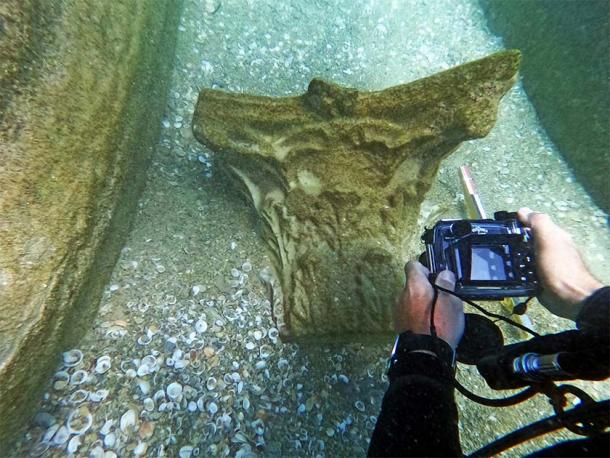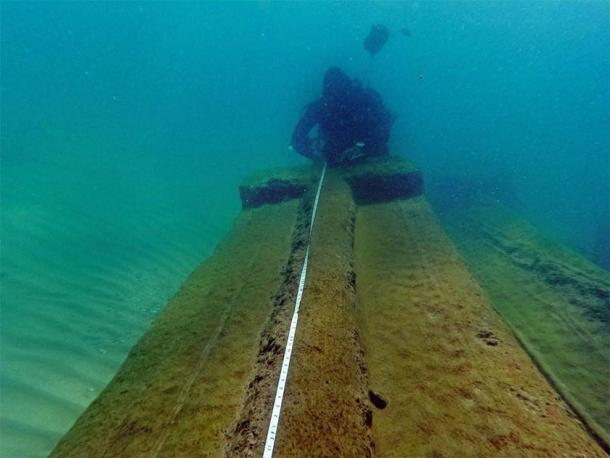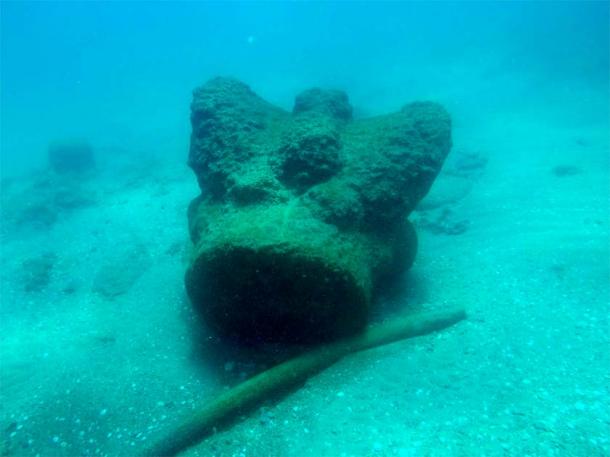Marble Columns Spotted by Swimmer Reveal Bountiful Roman Shipwreck
While swimming in the Mediterranean Sea off the coast of Israel, Gideon Harris unexpectedly stumbled upon a remarkable discovery. Little did he know that this uneventful event would lead experts to the remains of a Roman ship and its magnificent cargo.
Responsible Reporting in Israel Leads to Discovery of Roman Ship
As he gracefully glided through the water, Harris spotted what appeared to be several large pieces of smooth stone stuck in the sand on the sea bottom, all of which looked like they’d been carved by human hands. He then reported the find to the Israel Antiquities Authority (IAA), which launched an underwater search to get a closer look at the mysterious objects. What they found was a huge collection of 1,800-year-old marble stone columns, which had apparently been carried in a Roman-era cargo ship before being wrecked in a terrible storm.
- Digging the Deep Blue: Challenges and Triumphs in Underwater Archaeology
- Roman Era ‘Good Shepherd’ Ring Amongst Shipwreck Treasures Found in Israel
“We have been aware of the existence of this shipwrecked cargo for a long time,” Israel Antiquities Authority Director of Underwater Archaeology Koby Sharvit said in an IAA Facebook post announcing the news of the Roman ship. “But we didn’t know its exact whereabouts as it was covered over by sand, and we therefore could not investigate it.”
Thanks to Harris reporting the find, the IAA was able to explore the remains of the Roman ship and its treasures hidden beneath the surface. They believe they had been unveiled by recent storms. With the knowledge of the ship's location, the IAA initiated preliminary archaeological investigations, paving the way for extensive and thorough research.
The sunken cargo was found just off Yanai Beach, which is to the north of the resort city of Netanya in central Israel. It was only through a stroke of good fortune that swimmer Gideon Harris just happened to be in the right place at the right time to see the marble columns, which now constitute the oldest sunken sea cargo ever found in the Eastern Mediterranean.

The Roman shipwreck and its cargo, including ancient Corinthian-style columns were discovered by accident off the coast of Israel. (Israel Antiquities Authority)
Discovering Classical Corinthian Columns with Roman Shipwreck
Underwater archaeologists have been able to examine and photograph the marble artifacts extensively, since they are to be found in shallow seas ideal for easy diving. They could see that the marble columns were made in the Corinthian style, first created in ancient Greece but later imported by architects of the Roman world.
Recognized as a particularly valuable Classical architectural feature, Corinthian columns were made from the most precious marble and were reserved for important and expensive construction projects. “These fine pieces are characteristic of large-scale, majestic public buildings,” Sharvit said. “Even in Roman Caesarea, such architectural elements were made of local stone covered with white plaster to appear like marble. Here we are talking about genuine marble.”
The Corinthian marble columns were partially decorated, with vegetal imagery and carved capital letters. They were clearly meant to support a high roof, as the longest measured 20 feet (6 m) in length. This suggests they may have been destined to be used in the construction of a temple or a theatre in a Roman-held city somewhere near the Eastern Mediterranean coastline.
The IAA archaeologists believe the marble columns were shipped from the Aegean Sea area, likely from the lands of modern-day Greece or Turkey. The ship transporting them would have been headed to an active Eastern Mediterranean port city, possibly to Gaza or Ashkelon in ancient Israel, or even to Alexandria in Egypt. But the doomed Roman ship got caught in a terrible rainstorm before it could finish its journey.
“Such storms often blow up suddenly along the country’s coast,” Sharvit said, “and due to the ships’ limited maneuvering potential, they are often dragged into the shallow waters and shipwrecked.” Once the Roman ship started to go down it would have sunk quickly, given its great size and the enormous weight it was carrying. “From the size of the architectural elements, we can calculate the dimensions of the ship; we are talking about a merchant ship that could bear a cargo of at least 200 tons,” Sharvit stated.

Remains of the cargo carried on the sunken Roman ship. (Israel Antiquities Authority)
Remains of Roman Ship’s Cargo Reveals Construction Practices of Rome
One interesting aspect of this discovery relates to questions about how architectural items like the newly discovered Corinthian marble columns were carved and decorated during the Roman period. “Land and Sea archaeologists have long argued whether the Roman period imported architectural elements were completely worked in their lands of origin, or whether they were transported in a partially carved form, and were carved and fashioned at their site of destination,” Sharvit explained.
- Diver Discovers 900-Year-Old Crusader Sword Off Coast of Israel
- Finding the Lost City of Heracleion: Encountering Myth Under the Waves
“The find of this cargo resolves the debated issue, as it is evident that the architectural elements left the quarry site as basic raw material or partially worked artifacts and that they were fashioned and finished on the construction site, either by local artists and artisans or by artists who were brought to the site from other countries.”
It seems the Corinthian columns were only partially carved and decorated, meaning they wouldn’t have been finished completely until they arrived at their intended destination. This gave local builders and designers the chance to cater to local sensibilities by adding motifs that were popular in their regions.

Corinthian columns once transported on a Roman ship which sank 1,800 years ago off the coast of Israel. (Israel Antiquities Authority)
Keep Your Eyes Open when You’re Swimming!
The discovery of the Roman ship and the revelations that have already emerged would not have been possible if Gideon Harris had kept quiet about what he saw. Because he didn’t, the IAA has awarded him with a certificate of appreciation.
“Gideon’s report epitomizes the value of a citizen’s awareness regarding antiquities, and even more the importance of reporting them to the Israel Antiquities Authority,” said Eli Escusido, the IAA Director. “The cooperation of the community plays an important role in archaeological research.”
The United Nations estimates that there have been approximately three million shipwrecks in human history. At present, only about one percent of these have been identified and explored. A good portion of these lost vessels sunk in relatively shallow waters, which means that alert ocean swimmers and divers have a legitimate opportunity to follow Gideon Harris’s example and discover sunken ships or cargoes of their own.
Top image: Corinthian columns spotted by swimmer in Israel have led to discovery of Roman shipwreck. Source: Israel Antiquities Authority
By Nathan Falde



















